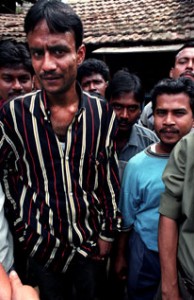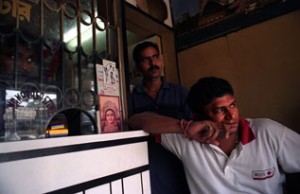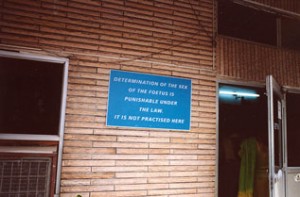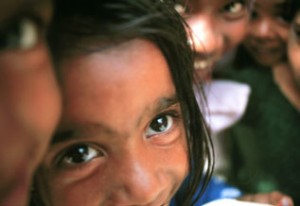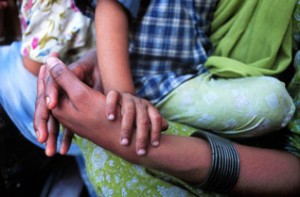By Sean Marciniak (class of 2004)
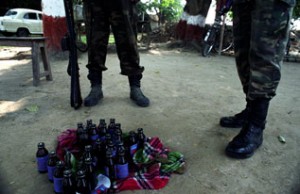
Indian Border Security Forces pose with confiscated cough syrup. Photograph by Mark Murrmann.
KALYANI, West Bengal, March 2003 – On a searing day here this spring, the Indian border patrol nabbed a boy trying to slip between thatched huts with two dozen bottles of cough syrup. His clinking contraband did more than cure a sore throat — each bottle had an alcohol content equal to three jiggers of whisky. Everybody on the India-Bangladesh border knows the cough syrup packs a kick, and really that’s all it’s good for. At 104 degrees Fahrenheit, it’s too hot to catch a cold here right now.
After border patrol soldiers marched the boy away, some hung back with a photographer, and posed behind the medicine bottles with their guns. Chest out, chin high, the soldiers stood over the cough syrup as if they’d slaughtered the last wild buffalo on the Great Plains.
Times might look easy on India’s eastern border but this is a land filled with beautiful lies. Never mind the wandering cows, the plush rice fields or the children that tease the local livestock. These stretches of the Indo-Bangladeshi border exist as an uncanny space of calm — an eye in a gathering storm that promises political conspiracy and international espionage.
India’s ruling party, the Hindu nationalist BJP, has begun a propaganda war that describes this border as tameless and dangerous; its new frontline in a war against terrorism. Bangladeshi immigrants, it says, are predominantly Muslim and hostile. Pakistani spies and terrorists float among them, the party argues, ready to get downright ugly when Pakistan tips its hat. About 40,000 Indian paramilitary troops have arrived here since February to stop this alleged border infiltration.
Bangladesh has denied the allegations, and Bangladeshi Foreign Minister Morshed Khan went a step further, telling a French news agency that India’s charges stemmed from “domestic compulsions.” However, he acknowledged that “small-scale intrusion” was possible and that “there is need for ensuring peace along this frontier.”
For a long time, all this was something one might expect of India’s more famous western border, the one it shares with Pakistan. It was always Pakistan that helped sneak in armed intruders, who then waged a “proxy war” over Kashmir. The infiltration in the west always drew more headlines, especially last year when it pushed both countries perilously close to nuclear war.
But this attention helped to change India’s border dynamics. In the past year, India’s western border has become much less porous, and those who insist on crossing the line now must look eastward. It’s the balloon effect in action, a law as old and tested as gravity.
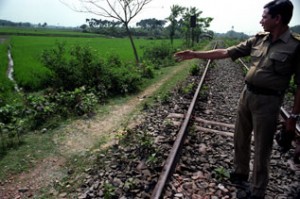
A member of India's Border Security Force points out a well-traveled path along the India-Bangladesh border, used by smugglers and local villagers alike. Photograph by Mark Murrmann.
Consequently, the Indo-Bangladeshi border has been getting more attention. In early January, India’s Deputy Prime Minister, L.K. Advani, looked over alarming Indian intelligence reports that estimated 16 million illegal Bangladeshi migrants had infiltrated the nation. Advani, who also commands India’s homeland security department, barked out to state leaders that India’s national security was at stake.
“For us in India, (immigration) is a hideous problem,” said Advani in an interview in New Delhi. “The numbers are enormous. It is not merely the eastern provinces that are affected. The immigrants have spread. Here in Delhi, there are colonies where only Bangladeshis live.”
However, a visit to the border, as well as extensive interviews with security officials, political leaders and local residents, show that Advani’s rhetoric has as much to do with his party’s politics as with national security. As the chief minister of New Delhi put it, a woman named Sheila Dikshit who heralds from the opposition Congress party and faces an election later this year: “He (Advani) comes up with these comments every time there is an election.”
And the Pakistani spies? Few doubt that ISI spies have infiltrated parts of West Bengal, but not to the degree claimed by the BJP. State leaders in West Bengal recently said they caught 60 men and women in 2002 who worked in ISI-sponsored spy rings, small cadres that mostly collected intelligence on border security troops. But Hindu nationalists have taken it a step further, whispering that spies are planning revolutions in East India that would cause it to secede to Bangladesh.
“Look, anything that happens in India is ISI,” said Jairam Ramesh, one of the most articulate spokesmen for the Congress Party. “Blame the ISI. The American embassy was attacked in Calcutta … ISI. It’s like what Bush says with Al Qaeda. Blame Al Qaeda.”
It has worked. Advani’s alarm bells have sounded shrilly, rousing even the sleepiest of dogs. The Marxist party of West Bengal, for example, which has ruled the state for 25 years and has always bitterly opposed the BJP, is for the first time on the defensive. On the issue of illegal immigration, it’s doing what many observers call a “substantive rethink” on its longstanding policy of nurturing migrants.
The Marxist’s policy change is bound to hurt many feelings. Hundreds of Bangladeshis cross into India every day, and have done so since 1971 when, helped by the Indian Army, Bangladesh was carved out of Pakistan. Getting specific numbers is guesswork, academics said, because no reliable census data exists. Indian intelligence officials estimate that up to 37,000 cross in a single month.
They come for different reasons. Poor Hindus — a minority in Bangladesh — seek refuge from what they describe as persecution of a new Muslim government, sections of which are openly anti-India. Poor Muslims, who make up an estimated two-thirds of the immigrants, are economic refugees, having fled one of the most penniless and crowded nations on earth — a country best known for biblically proportioned floods.
If it’s economics that makes them pack their bags, it’s geography that helps them move across. West Bengal’s 1,000-mile border with Bangladesh, for example, wanders through the Ganges River delta like a love-struck teenager. It crosses and re-crosses rivers, bisecting fields as flat as pancakes. There is no Rio Grande here to mark the international border, nor any sort of fence that extends for any helpful length.
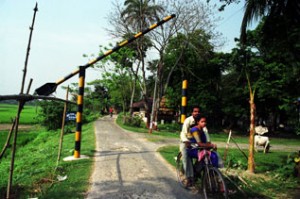
What little traffic there is flows freely along a border road that passes through the village of Kalyani, near Bongaon, West Bengal. Photograph by Mark Murrmann.
Unlike the U.S.-Mexico border, this line does not divide populations of different ethnicity. The entire area is home to an ethnic group known as Bengalis, and telling a Bangladeshi apart from an Indian here is as hard as distinguishing between twins. What turns this headache into a migraine is that India has no national identity card system — Advani is vigorously campaigning for one — and proving someone is not a citizen is virtually impossible.
Take the town of Petrapole, where the border is little more than an imaginary line marked by white stones that only sometimes can be sighted in the thick grass, and it’s easy to step into Bangladesh by accident. A short walk from the official customs crossing, people trickle out from a banana grove, then lope across a rice field into Bangladesh without so much as a hop.
Wiping away sweat and watching from a nearby railroad track sat soldiers from the Border Security Force. The BSF, the largest paramilitary force in the world, is charged with wringing a tourniquet around borderlands traffic, but the 96,000 stationed on the eastern border have only recently shown some degree of effectiveness. Some say it’s the increased numbers. Others say Advani’s focus on the east has forced BSF commanders to curtail what has been described as rampant corruption, a characteristic so often discussed that the BSF has become known as the Border Smuggling Force.
Still others wonder why everyone is fussing. Problems on the border, they argue, have existed since 1948, when the subcontinent was cleaved into India, West Pakistan and East Pakistan. For years, borderland smuggling outfits and undocumented immigration came and went without so much as a second glance. Nothing has changed, they say, but the political ambitions of the ruling party behind Advani, the BJP. And the new nervousness of the ruling Marxists.
Making the Marxists See Red
West Bengal, internationally most famous for its giant tigers, is known within India for loftier reasons: it’s the country’s best-governed state, thanks to the continuous re-election of a government as unique as its big cats. The Left Front, led by the Communist Party of India-Marxist, has remained in power for a quarter century. Under it, the literacy rate hovers at 76 percent and sociologists have noted that West Bengal doesn’t see the high degree of Hindu-Muslim violence that has plagued the rest of India.
Because of its ideology and electoral success, the Left Front has long been the bane of central New Delhi governments. Its grassroots organizing and discipline have caused their political enemies endless headaches, such that even the BJP, so mighty in New Delhi, has maintained an anemic presence here. In 1984 the state garnered less than half a percentage of the vote; since capturing power at the federal level, it’s only managed to raise its share of the vote to six percent.
But the BJP is poised for a power grab, thanks to recent outcries over immigration and terrorism.
The 2001 census confirmed what had long been suspected: that the demographics of West Bengal have changed to the advantage of Muslims. In districts like Maldah, for example, almost 50 percent of the rural population is Muslim; in Murshidabad, it’s more than 60 percent. Blocs of Hindu voters have grown nervous and the BJP has been quick to stoke these fears.
Wary that this could give the BJP a foot in the state’s door, the Marxists, many political observers say, have decided to realign their immigration policy with Advani’s more conservative vision. Or, at least, make noises to that effect.
“We had the immigration problem here long before the Kashmir problem but that was not so serious,” said Jayanta Roy, leader of the Forward Bloc, a member of the ruling Left Front. “But then we got information from the Central government that Muslim fundamentalists, with the political patronage of the Pakistani government, are very much active in India and they have chosen Calcutta as a soft target.”
In recent months, the Marxists have called for more security and deportations. They have even talked of “modernizing” the madrassahs along the border, accusing them of breeding fundamentalism. Such language is unprecedented, coming from a party that encouraged an open border and accommodated so-called hostile Bangladeshis. Why? The reason is simple: the immigrants vote.
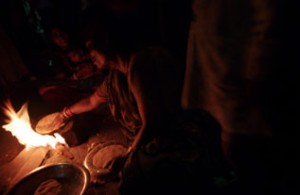
A Bandladeshi woman cooks dinner for her family on a busy sidewalk in downtown Calcutta. Photograph by Mark Murrmann.
How is an even more interesting matter. In exchange for support during elections, Indian politicians were rumored to distribute “ration cards” to newly arrived Bangladeshis. Ration cards, equivalent of food stamps, are key to the transaction because, aside from allowing one to purchase subsidized rice, wheat and sugar at local stores, these documents serve as identity cards. Ration cards are what gets you on the local voter registry.
Since the accusations were made years ago, no one publicly admitted to this vote-getting strategy. However, recent interviews with political party members drew outright or partial admissions.
Nirupam Sen, the second-most powerful Marxist in West Bengal, gave the following response: “It differs from area to area; I cannot spell out these things. I cannot make any comments on exactly where, who, how it has been done. That is absolutely not possible.”
Neither can leaders in West Bengal’s immigrant communities.
Bangladeshis currently congregate in such places as Calcutta’s Municipal Ward 30, a squalid neighborhood in the north of the city. Ward 30 has steadily has grown over the last two decades, slowly spilling over the banks of a nearby black water canal. Infrastructure is scarce; people are not. Thatched homes, dirt roads, and outhouses are the order of the day. But locals say this den of illegal immigrants manages to squeeze a population of 9,000 into a space that measures 500 meters by about 33 meters.
The leader of the neighborhood is identifiable by his large pot belly, the only one in sight.
“No one here is Bangladeshi,” said Basander Das, who officially is a branch committee member for the Marxists. Questioned further, he acknowledged that 600 to 700 neighbors couldn’t produce documents, and that many feared Advani’s latest grumblings.
“No one is Bangladeshi,” he repeated, “but we fear that if there is a drive against illegal settlers, we may be affected unnecessarily. No one here has been dislocated, but if there is any move, there will be rioting.”
Feeding the Fear
Das’ warning betrays the growing unease in the Left Front as it prepares its bitter pill for Bangladeshi immigrants. To stem mass demonstrations, state leaders have said, time and again, that its campaign is aimed at only those who are “terrorists backed by Pakistan and the ISI.” Of which there aren’t that many.
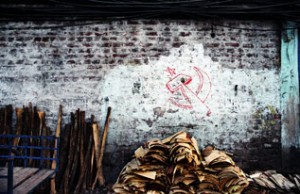
A fading hammer and sickle painted on a wall in Calcutta's Municipal Ward 30, a community of over a thousand Bangladeshi immigrants. Photograph by Mark Murrmann.
A Calcutta Police inspector agreed to meet with reporters in a relative’s shop, one nestled deep in the side of a narrow alley. Asked about the presence of terrorist ISI agents in West Bengal, he looked pained to say that he had not encountered any Pakistani spies in Calcutta for five years. “We are searching the pebbles,” he said, “but it is very tough.”
Despite limited information, Advani and his followers have been able to gain support in hostile West Bengal by taking an international slogan — the war on terrorism — and localizing it.
If Advani has set the tone, his junior colleagues in the party are amplifying it to alarmist levels. According to regional BJP leaders, there are ISI spies lurking in every border village and immigrant colony, blending into places like the village of Kalyani and Calcutta’s Municipal Ward 30. According to them, secret agents are poised to incite insurrection at the command of Islamabad.
“You don’t expect part of America to break away and join Mexico, but over here, the problem is that if a part of India becomes a Muslim majority, then we’d be scared,” said Tathagata Roy, president of West Bengal’s BJP chapter. Asked what this fear was based on, Roy said: “I have no access to intelligence reports. I go largely on newspaper reports … and what I get on the net.”






